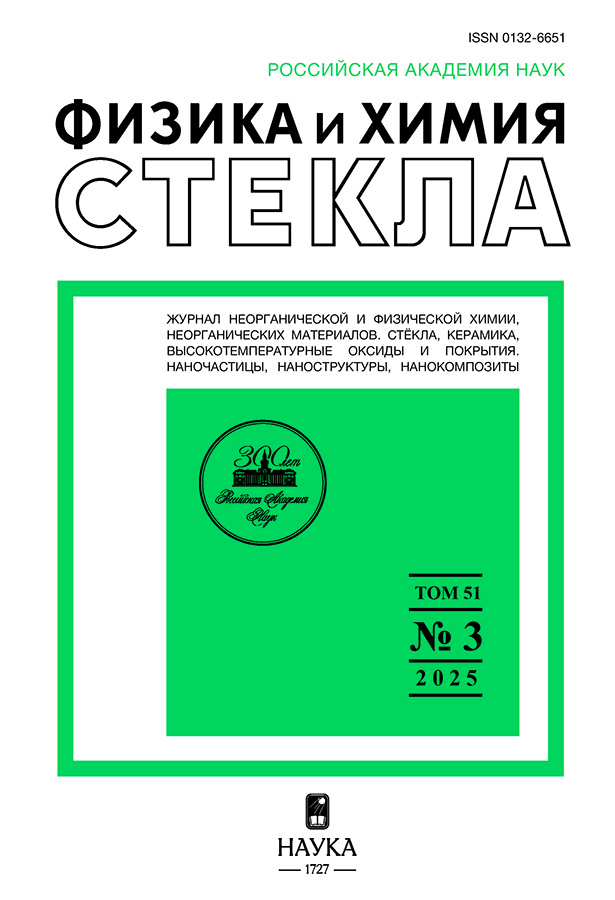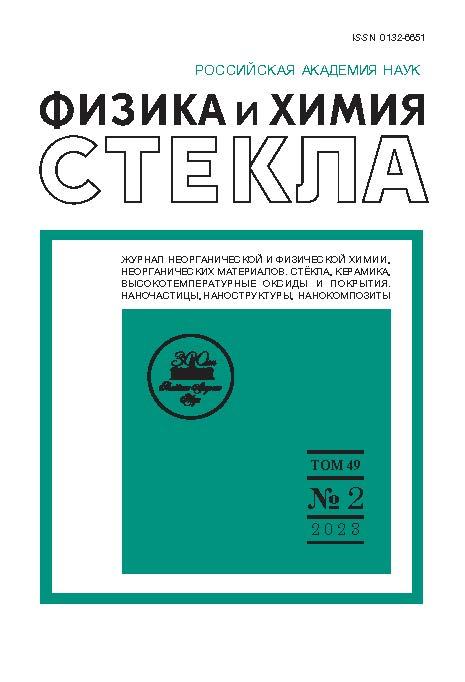Кристаллизация натриевоборосиликатного стекла с добавкой Cr2O3
- Авторы: Конон М.Ю.1, Полякова И.Г.1, Саратовский А.С.1,2, Данилович Д.П.2, Анфимова И.Н.1
-
Учреждения:
- Институт химии силикатов им. И.В. Гребенщикова РАН
- Санкт-Петербургский государственный технологический институт (технический университет)
- Выпуск: Том 49, № 2 (2023)
- Страницы: 204-208
- Раздел: КРАТКОЕ СООБЩЕНИЕ
- URL: https://rjonco.com/0132-6651/article/view/663259
- DOI: https://doi.org/10.31857/S0132665122600881
- EDN: https://elibrary.ru/NWDSFG
- ID: 663259
Цитировать
Полный текст
Аннотация
Cтекло состава 6Na2O·22B2O3·70SiO2·2Cr2O3 изучено методами растровой электронной микроскопии, рентгенофазового анализа и дифференциально термического анализа в зависимости от длительности термообработки при температуре 550°С. Установлено, что в процессе термообработки в течение 24–96 ч в исследованном стекле формируется ликвационная структура с взаимопроникающими фазами, а также формируется кристаллическая фаза эсколаита – Cr2O3. При максимальной длительности термообработки – 96 ч в объеме стекла образуется кристобалит, что сопровождается уменьшением температуры стеклования маловязкой фазы. Интенсивность пиков эсколаита при этом уменьшается. Кристаллизация фаз Cr2O3 и SiO2 происходит, по-видимому, за счет вещества маловязкой фазы.
Об авторах
М. Ю. Конон
Институт химии силикатов им. И.В. Гребенщикова РАН
Email: marina-konon@mail.ru
Россия, 199034, Санкт-Петербург, наб. Макарова, 2
И. Г. Полякова
Институт химии силикатов им. И.В. Гребенщикова РАН
Email: marina-konon@mail.ru
Россия, 199034, Санкт-Петербург, наб. Макарова, 2
А. С. Саратовский
Институт химии силикатов им. И.В. Гребенщикова РАН; Санкт-Петербургский государственный технологический институт (технический университет)
Email: marina-konon@mail.ru
Россия, 199034, Санкт-Петербург, наб. Макарова, 2; Россия, 190013, Санкт-Петербург, Московский пр., 26,
Д. П. Данилович
Санкт-Петербургский государственный технологический институт (технический университет)
Email: marina-konon@mail.ru
Россия, 190013, Санкт-Петербург, Московский пр., 26,
И. Н. Анфимова
Институт химии силикатов им. И.В. Гребенщикова РАН
Автор, ответственный за переписку.
Email: marina-konon@mail.ru
Россия, 199034, Санкт-Петербург, наб. Макарова, 2
Список литературы
- Rao L.N., Rao M.V.S, Tirupataiah Ch., Aruna V., Naga Lakshmi M. Influence of chromium ions on photonic applicability of Na2O–Bi2O3–B2O3–SiO2 glass system // Optics Communications. 2021. V. 480. P. 126496.
- Ebrahimi E., Rezvani M. Optical and structural investigation on sodium borosilicate glasses doped with Cr2O3 // Spectrochimica Acta Part A: Molecular and Biomolecular Spectroscopy. 2018. V. 190. P. 534–538.
- Marzouk S.Y., Gaafar M.S. Ultrasonic study on some borosilicate glasses doped with different transition metal oxides // Solid State Communications. 2007. V. 144. P. 478–483.
- Aktas B., Yalcin S., Dogru K., Uzunoglu Z., Yilmaz D. Structural and radiation shielding properties of chromium oxide doped borosilicate glass // Radiation Physics and Chemistry. 2019. V. 156. P. 144–149.
- Ravi Kumar G., Gopi Krishna M., Rao M.C. Cr3+ doped NaF–ZrO2–B2O3–SiO2 glass ceramic materials for optoelectronic device application // Optik. 2018. V. 173. P. 78–87.
- Polyakova I.G. The Criterion for the Crystallization Ability Assessment as Applied to Borate Glass Powders and Monoliths // Entropy. 2019. V. 21. P. 994–1014.
- Breneman R.C., Halloran J.W. Kinetics of Cristobalite Formation in Sintered Silica // J. Am. Ceram. Soc. 2014. V. 97. № 7. P. 2272–2278.
- Горогоцкая Л.И., Мицюк Б.М. Физико-химические превращения кремнезема в условиях метаморфизма. Наукова Думка, Кте. 1980. 236 с.
- Полякова И.Г., Морозова Э.В. Определение положения купола ликвации методом ДТА на примере натриевоборосиликатных стекол // Физ. и хим. стекла. 1988. Т. 14. № 1. С. 140–143.
- Sandu V., Nicolescu M. S., Kuncser V., Damian R., Sandu E. Magnetic glass-ceramics // J. Advanced Ceramics. 2012. V. 1(2). P. 138–143.
Дополнительные файлы













